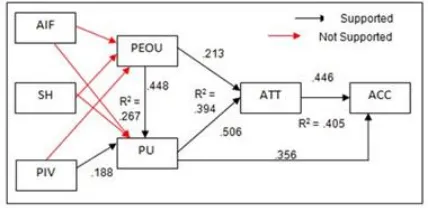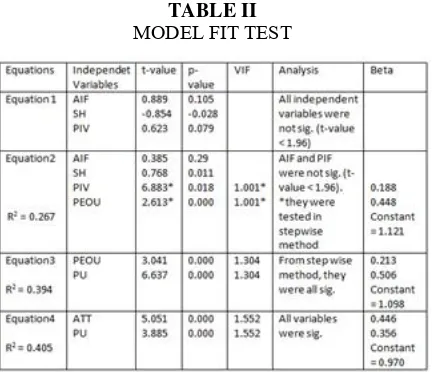Study Habits, and Perception on Instruction on
Students’ Acceptance towards Using e-CMS
Shulamite Damayanti
Accounting Lecturer Ma Chung University, Indonesia. [email protected]
Saarce Elsye Hatane
Accounting Lecturer Petra Christian University, Indonesia. [email protected]
Abstract- Participation and
communication methods in education institution have changed since the use of information and communication technology (ICT) has been widespread. Teaching-learning processes are simplified by the Internet and related technologies, including the use of World Wide Web to assist teaching process and to convey course contents. Electronic course management system (e-CMS) as part of eLearning bridges the gap between traditional face-to-face instruction and independent learning. It also provides various roles that support the students to study with an effective and efficient way.
The readiness and acceptance of students as one of e-CMS’ main user is critical to determine the acceleration of the e-CMS implementation. Ma Chung University (MCU) is a private university in Indonesia with core competencies as International Standards University and IT-Based Campus has implemented e-CMS to perform its excellence, effectiveness & efficiency of learning process. The system is called Ma Chung Learning Gateway (MLG). This study will examine the MCU students’ acceptance toward using MLG. Technology acceptance model (TAM) by Davis and Warshaw (1989) will be employed and combined with availability of internet facilities, study habits, and perception on
instruction in e-CMS as the external factors.
Keywords- availability of internet facilities, e-CMS, perception on instruction, study habits, and TAM.
I. INTRODUCTION
eLearning has become a popular learning approach in higher education. It enables the delivering of learning material to the students through Internet, computer, or other devices related to computer-based training. There are some concepts in the utilization of information technology in education, one of which is electronic course management systems (e-CMS). E-CMS is the use of information technology to help the teachers and the students to interact in the learning process, that homework or teaching materials can be downloaded from a web.
Ma Chung University (MCU) is a private university in Indonesia as IT-Based Campus that has applied e-CMS through its system, called Ma Chung Learning Gateway (MLG). MLG is a system or web enables the lecturer to upload the learning materials, the homework, or any announcements related the learning process.
of computer technology (Hu et al., 1999). The evaluation of e-CMS using the TAM focusing on lecture acceptance has been researched and shows that perceived usefulness has the strongest effect on intention to use (Hatane and Tangke, 2009). It is different with this paper which evaluates e-CMS using the TAM focusing on student acceptance.
II. LITERATURE REVIEW
Electronic Course Management System (e-CMS) is part of electronic learning systems that deliver learning in an academic program by using information and communication technology (ICT) means via the web or network server. The systems bridge the gap between traditional face-to-face instruction and independent learning, and also help educators to organize and distribute course content, administer course exercise or quizzes, and track student progress (Daniels, 2009).
TAM was created based in the theory of reasoned action (TRA) by Fishbein and Ajsen (1975), and then developed by Davis (1989). From the TAM research, Davis (1989) defined perceived ease of use as how users perceive that the technology will be effortless, while perceived of usefulness defined to how the users perceive that using the technology will improve their work performance. These two factors are considered to influence users’ attitude toward using the technology which determines the behavioral intention to use that technology, while perceived ease of use also influences perceive usefulness. Perceived usefulness has straight impacts on attitude and actual use, perceived ease of use affects on attitude and actual use indirectly through perceived usefulness.
TAM expresses that perceived ease of use and perceived usefulness are influenced by external variables. Jebakumar & Govindaraju (2009) used availability of internet and study habits as two of four
external factors in order to measure students’ perceptions towards virtual learning environment (VLE).
Qiu, et al. (2003) concluded that ease of use of the features was the most priority factor when selecting a web-based course management system. Zhang, et al. (2008) also found that students’ perceived ease of use had significant positive relationship on students’ perceived usefulness in using the E-CMS.
Masrom (2007), on his research, revealed that both students’ perceived ease of use and perceived usefulness had significant influence on students’ attitude toward using eLearning systems. Positive perception of technology’s usefulness was the most important factor to increase students’ attitude toward using eLearning.
The hypotheses conducted in this study were:
H1: Availability of internet facilities (AIF) has significant effect on perceived ease of use (PEOU)
H2: Availability of internet facilities (AIF) has significant effect on perceived of usefulness (PU)
H3: Study habits (SH) has significant effect on perceived ease of use (PEOU)
H4: Study habits (SH) has significant effect on perceived of usefulness (PU)
H5: Perceived on instruction in virtual learning system (PIV) has significant effect on perceived ease of use (PEOU)
H6: Perceived on instruction in virtual learning system (PIV) has significant effect on perceived of usefulness (PU)
H7: Perceived easy of use (PEOU) has significant effect on perceived of usefulness (PU)
H9: Perceived of usefulness (PU) has significant effect on attitude towards using (ATT)
H10: Perceived of usefulness (PU) has significant effect on acceptance (ACC)
H11: Attitude towards using (ATT) has significant effect on acceptance (ACC)
Fig. 1 Research Model
III. RESEARCH METHODOLOGY AND RESULT
There were four equations from the Conceptual framework, those were:
PEOU = a + b1AIF + b2SH + b3PIV + e ..(eq. 1)
PU = a + b1AIF + b2SH + b3PIV
+ b4PEOU + e ………….(eq. 2)
ATT = a + b1PEOU + b2PU + e……...…..(eq. 3)
ACC = a + b1ATT + b2PU + e ……...…(eq. 4)
The instrument used to collect data was a set of 5 points Likert type-scale questionnaire which had been adjusted from the basic TAM questionnaire (Masrom, 2007) and modification external variables (Jebakumar & Govindaraju, 2009). The questions were translated to Indonesian language (bahasa). The questionnaire consists of 35 questions that reflected each of indicator variables in the conceptual framework. The questionnaire was distributed to 149 MCU’s accounting students in four different study level
Respondents’ demography profile showed 69% of them were female and 31% were male; ages level distribution 51% for 17-19 years old and 49% for 20-22 years old. 23.5% of the respondents were in second
semester, 29.5% in fourth semester, 33.6% in sixth semester and 13.4% in eight semester. Students in the eight semester were doing one major course and or finishing thesis. This study used multiple regression analysis from SPSS 16 to execute the conceptual model.
This study used Cronbach alpha to test the reliability of each variables. Table I indicates that all variables exceed the adequate levels for reliability (α>0.6).
TABLE I
RELIABILITY TEST
After doing reliability test, the researchers run the multiple regression and did the fit test. In order to get the fit model, first each variable must meet one of these two conditions which are t-test must be greater than 1.96, or Pearson correlation test sig. 2 tailed, α < 0.05. Second, the model must free from multicollinearity by having VIF (variance inflation factors) higher than 1 ( > 1.000). The multiple regression run in step wise method. From all of the tests, the hypotheses model shown in figure 2.
TABLE II
MODEL FIT TEST
(Eq.1) PEOU = a + b1AIF + b2SH + b3PIV + e
Equation one covered hypotheses one, three, and five. Because there were no significant variables in the equation, therefore the hypotheses one, three, and five were not supported. It means that MC accounting students’ perceived ease of use was not supported by any of those external variables used in this study.
(Eq.2) PU=1.121+0.188PIV+0.448PEOU+e Equation two covered hypotheses two, four, six and seven. The equation means that MC accounting students’ perceived usefulness of MLG significantly affected by perceived on instruction in VLE in very weak correlation and perceived ease of use in moderate correlation. The ability of those two sig. variables in explaining PU was 26.7%
(Eq.3) ATT=1.098+0.213PEOU+0.506PU + e. Equation three covered hypotheses eight and nine. The equation means that MC accounting students’ attitude towards using MLG were significantly affected by their perceived ease of use of MLG in weak correlation and perceived ease of use of MLG in moderate correlation. The ability of those two sig. variables in explaining ATT was 39.4%
(Eq.4) ACC=0.970+0.446ATT+0.356PU+e. Equation four covered hypotheses ten and eleven. The equation means that MC accounting students’ acceptance significantly affected by their attitude towards using MLG in moderate correlation and their perceived usefulness of MLG in weak correlation.
The implications from those analysis are that MC management should increase MC accounting students’ attitude towards using MLG because it was the strongest affected variable in the model, and their attitude strongly affected by their perceived of usefulness in using MLG. Therefore, this study concluded that perceived of usefulness directly and indirectly strongly effected MC accounting students’ acceptance towards using MLG. The accounting students’ perceived of usefulness moderately affected by their perceived ease of use in using MLG, and perceived on instruction in VLE as the external factor. MC management should maintain all of those factors to increase the students’ acceptance in using MLG. In the perception of instruction in VLE, most respondents agree and strongly agree that there were clear instructions from lecturer in the MLG and therefore MLG was useful to support face-to-face learning process in class. The training before using and the instruction from lecturers to use the MLG were important to develop the students’ perceived ease of use and perceived of usefulness towards using MLG.
Based on the results, there are two conclusions on accounting students’ acceptance of MLG. First, the positive students’ attitudes and perceived usefulness in using MLG were the most important factors to be concerned by MC management in increasing the students’ acceptance of MLG. Second, the important external factor in affecting students’ acceptance of MLG was perceived on instruction in VLE. MC management should give explanation to the MC lecturers to develop clear instruction in MLG in order to increase students perception.
something in this research, or use another method.
As a recommendation, future study need to evaluate electronic course management implementation in several universities in Indonesia to support the improvement of learning environment in the country, not only from students’ perspective, but also from other users’ perspective (lecturer and management).
REFERENCES
[1] Daniels, Paul. (2009). Course Management Systems and Implications for Practice.
International Journal of Emerging Technologies & Society Vol. 7, No. 2, pp: 97 – 108.
[2] Davis, F.D. (1989). Perceived Usefulness, Perceived Ease of Use and User Acceptance of Information Technology. MIS Quarterly, 13(3),
pp: 319-339.
[3] Davis, F.D., Bagozzi, R.P., & Warshaw, P.R. (1989). User Acceptance of Computer Technology: A Comparison of Two Theoretical Models. Management Science, 35 (8), pp: 982-1003.
[4] Hatane, Saarce E., and Tangke, N. (2010). Evaluation of E-CMS using TAM: Focusing on Lecturer Acceptance. Proceedings The 3rd International Conference: New Directions in Education. Graduate School of Education. Assumption University.
[5] Hu, P.J., Chau, P.Y.K., Sheng, O.R.L., & Tam, K.Y. (1999). Examining the technology acceptance model using physical acceptance of telemedicine technology. Journal of Management Informastion Systems, 16(2), 91-112.
[6] Jebakumar, C., Givindaraju, P. (2009). A Study of Virtual Learning Environment with Reference to The Perceived Preparedness of Collage Students in Tamilnadu (South India).
Communication Policy Research South 4th
Conference.
[7] Masrom, M. (2007). Technology Acceptance Model and E-learning. Proceedings from 12th International Conference on Education. Sultan Hassanal Bolkiah Institute of Education, Brunei Darussalam.
[8] Qiu, Maying., Davis, Steve., and Sadie Gregory. (2003). Student Attitudes toward Web-Based Course Management System Features.
International Association for Computer Information System (HS) (4)

